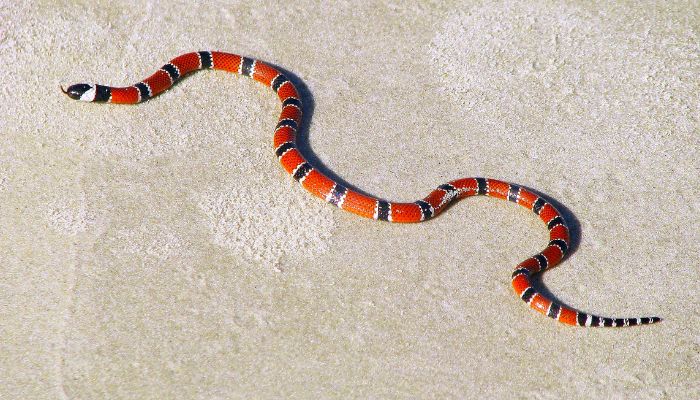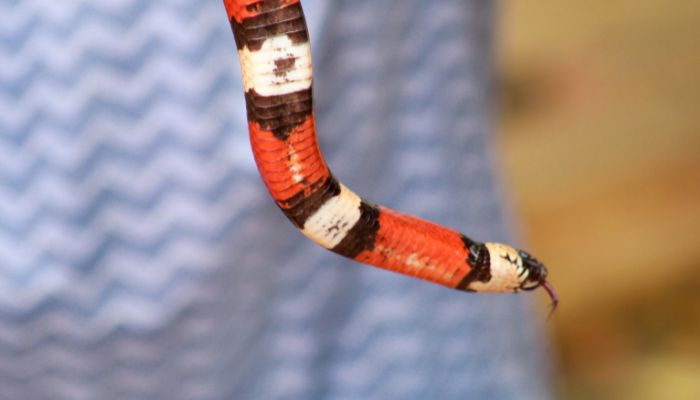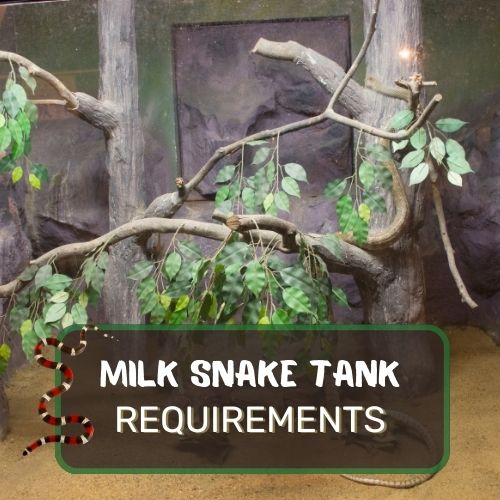Milk snakes, with their vibrant colors and docile nature, have slithered their way into the hearts of many reptile enthusiasts. But one of the burning questions for new and seasoned snake owners alike is about their heating needs.
Yes, milk snakes require a heat lamp. These reptiles thrive in temperature gradients between 75°F to 85°F. A heat lamp ensures they get the warmth necessary for digestion, metabolism, and overall well-being, emulating the conditions of their natural habitat.
How do we replicate the warmth of their natural habitat in our homes?
This article dives deep into the importance of temperature for these beautiful creatures, how to emulate their natural environment, and the signs to look out for if things aren’t quite right.
We’ll also tackle frequently asked questions to ensure your slithery friend stays comfy and happy.
Dive in!

Table of Contents
Understanding the Importance of Temperature for Milk Snakes
Alright, let’s dive right into the heated debate! Do milk snakes really need that cozy heat lamp, or are they cool just lounging at room temperature? To answer this, we need to first understand the intricate relationship between milk snakes and temperature.
Why Temperature Matters for Reptiles
Reptiles, unlike us warm-blooded mammals, are ectothermic. That’s just a fancy way of saying they can’t generate their own body heat. Think of them like a solar-powered calculator. We, on the other hand, are like battery-operated ones.
While we can keep going in any weather, reptiles need the sun—or, in the case of domestic reptiles, a suitable artificial heat source—to get their energy going.
So, just as you wouldn’t expect that solar calculator to work in the dark, you can’t expect a milk snake to thrive without the right temperature.
The Ideal Temperature Range for Milk Snakes
Let’s get straight to the numbers! Milk snakes aren’t picky divas, but they do have their preferences. These slithering beauties thrive at temperatures between 75°F to 85°F (24°C to 29°C). It’s like their personal comfort zone.
Anything too low or too high, and they’ll probably give you a side-eye (if they could, of course!).
Within their enclosures, it’s also a good idea to have a gradient – a warmer basking spot at around 85°F and a cooler spot for them to chill when they feel like it.
Digestion and Metabolic Rates
Ever eaten a huge meal and then felt like you could conquer a marathon? No? That’s because, unlike reptiles, our digestion isn’t that closely tied to temperature. For milk snakes, temperature is directly related to how quickly they can digest their food.
At the ideal temperature range, their metabolic rates are optimized, ensuring that the mice or rats they’ve devoured are efficiently processed. In simpler terms, it’s like giving them the best environment to enjoy and digest that delightful rodent meal.
But if it’s too cold? Digestion slows down, and the food can even begin to rot inside them. Yikes! It’s like trying to cook a pizza in a fridge – not very effective.
The Risk of Respiratory Infections in Cooler Temperatures
Cold and damp conditions are the ultimate recipe for respiratory infections in milk snakes. Imagine being stuck in a cold, wet environment without a warm blanket or cup of hot cocoa.
It’s miserable, right?
Similarly, when milk snakes are left in temperatures that are too low, especially if the humidity isn’t right, they can develop respiratory issues.
Keeping them in their optimal temperature range is more than just about comfort—it’s about health. It’s like ensuring they have a snug winter coat during the chilly months.

Daily Temperature Cycle: Daytime vs. Nighttime
ust as you might start your day with a piping hot cup of coffee and end it with a refreshing iced tea, milk snakes also appreciate some daily temperature variation.
The Importance of Temperature Fluctuations
Here’s the deal: in the wild, it’s never a constant temperature all day and night. The sun rises, heats things up, then sets, and everything cools down. Milk snakes are used to this. These fluctuations play a role in their natural rhythms and behaviors.
By simulating this in captivity, you’re giving them a taste of the wild, right in your living room.
How to Achieve a Natural Day-Night Cycle
Achieving this is simpler than you might think. During the day, make sure the basking area of their enclosure reaches the upper end of their preferred temperature range. But when night falls? Turn off that heat lamp, and let the temperature drop a bit.
Just make sure it doesn’t go too low. Investing in a timer for the heat source can automate this, making life easier for both of you!

Natural Habitat and Temperature Range
To truly get into the headspace of a milk snake, let’s take a virtual trip to its natural habitat.
Where Do Milk Snakes Live in the Wild?
Milk snakes are North American natives, and they’ve set up home in a variety of places. From the meadows of the Midwest to the forests of the East, they’ve found cozy nooks everywhere.
Some even chill (literally!) in the higher altitudes of mountainous regions.
Temperature Ranges in Their Natural Habitat
In these diverse habitats, temperatures can vary wildly. On a hot summer day, it might reach up to the high 80s or even 90s (Fahrenheit). But nighttime or higher altitudes? It can drop considerably. However, remember: milk snakes are adaptable.
They won’t just lay out in the open during scorching heat or freezing cold.
How They Cope with Temperature Fluctuations
Milk snakes are pros at finding the perfect spot. On those blazing hot days, they might burrow underground or find a shady spot under a rock or log. In cooler times, they’ll seek out those sunny patches to soak up the warmth.
It’s this ability to “thermoregulate” — adjusting to the surrounding temperature — that makes them such survivors. In captivity, we can help them out by providing both warm and cool zones in their enclosure.
Think of it as giving them options for their daily temperature dance!

Choosing the Right Heat Lamp for Your Milk Snake
Picking the perfect heat lamp for your milk snake is a bit like shopping for the right pair of shoes. It’s got to be comfy, fit just right, and of course, be stylish (okay, maybe not stylish, but effective).
But with so many options out there, where does one start? Fear not! We’re here to guide you through the heat lamp aisle.
Different Types of Heat Lamps: Pros and Cons
Incandescent Bulbs:
- Pros: Easily available, emit both light and heat.
- Cons: Short lifespan, not energy efficient.
Ceramic Heat Emitters:
- Pros: Long-lasting, only emits heat (no light), great for maintaining nighttime temperatures.
- Cons: More expensive, can get very hot.
Infrared Heat Bulbs:
- Pros: Provides “deep heat” which many reptiles seem to love, available in different wavelengths for day and night.
- Cons: Can alter the color of your reptile’s environment, may not be as energy efficient.
Wattage and Size Considerations
Just like you wouldn’t use a spotlight to read a book, the size of your enclosure and the distance from the lamp to the snake will dictate the wattage you need.
Smaller tanks might only need a 50-watt bulb, while larger setups could require 100 watts or more. Measure the temperature regularly to adjust as needed.
Potential Dangers of Heat Lamps
Heat lamps, if not monitored, can become a hazard. From causing burns to your beloved snake to even being a fire risk, it’s essential to handle them with care.
Tips to Avoid Overheating or Burns
- Use a Thermostat: This nifty device will automatically turn off the heat source if things get too toasty.
- Guard It Up: Use a protective guard or cage around the lamp to prevent your curious snake from getting too close.
- Distance Matters: Ensure the heat lamp isn’t too close to the snake. It’s all about that gradient!
Alternatives to Heat Lamps
Not sold on heat lamps? There are other ways to keep your milk snake cozy. Heat mats, for example, provide warmth from below, simulating the earth’s natural heat. Radiant heat panels can also be a great choice, especially for larger enclosures.
Both offer gentle warmth without the light, making them perfect for 24/7 use. Whatever you choose, always keep your snake’s comfort and safety in mind. Because a happy snake is a happy life!

Signs Your Milk Snake Needs More (or Less) Heat
Have you ever watched someone shivering in cold or fanning themselves in heat and thought, “Geez, they really should move to a more comfortable spot!”? Well, your milk snake may be sending similar signals—just without the dramatics.
Here’s how to play detective and understand what your milk snake is trying to tell you.
Recognizing Distress in Milk Snakes
Unlike our more vocal pet counterparts (yes, I’m looking at you, barking dogs), milk snakes are silent communicators. They won’t hiss out their discomfort, but if you look closely, they’re definitely “speaking.”
Physical Signs of Inadequate Heating
- Lethargy: If your snake seems more sluggish than usual, it might be too cold.
- Loss of Appetite: Cold milk snakes often don’t eat, as low temperatures hinder digestion.
- Skin Discoloration: Overexposure to high heat might cause a noticeable discoloration.
Behavioral Clues
- Always in the Basking Spot: If your milk snake is perpetually hanging out under the heat lamp, it’s probably craving more warmth.
- Constantly Hiding: If it’s frequently burrowed or hiding in cooler spots, it might be signaling it’s too hot out there!
- Restlessness: A snake that’s constantly on the move, trying to find that “just right” spot, is hinting at temperature discomfort.
Reading your snake might seem like interpreting an abstract painting at first, but with time and observation, you’ll become a pro. Remember, their comfort is in your hands. Make sure those hands are well-informed and attentive!
Summary
You’ve journeyed through the intricate world of milk snake care, understanding the pivotal role temperature plays in their well-being. From mimicking natural day-night cycles to choosing the right heat lamp, ensuring your snake’s comfort is paramount.
Remember, every effort you make mirrors their wild habitat, fostering their health and happiness. With the knowledge you’ve gained, you’re well-equipped to provide your slithering companion with the warmth and care they deserve.
Keep up the great work, and here’s to many cozy moments with your milk snake!
FAQ
Everyone has questions, and lucky for you, we’ve got the answers. Let’s tackle some of the burning questions about milk snakes and their heating needs.
How much heat does a milk snake need?
Milk snakes enjoy a comfy temperature range of 75°F to 85°F (24°C to 29°C). It’s their sweet spot. Remember to provide a gradient, so they have options!
What is the best lighting for a milk snake?
While heat is crucial, lighting plays a role too. A regular daytime light that mimics natural daylight is excellent. This helps set a regular day-night rhythm for your snake.
Do milk snakes need a heat lamp during the day?
Yes, they do! A heat lamp during the day provides that necessary warmth for their basking sessions. Just ensure the lamp doesn’t overheat the enclosure.
Do milk snakes need UV light?
Milk snakes don’t necessarily need UV light, as they aren’t as dependent on it as some other reptiles. However, a little UV exposure can be beneficial for synthesizing vitamin D and absorbing calcium. It’s like them getting a bit of sunshine vitamin!




0 Comments